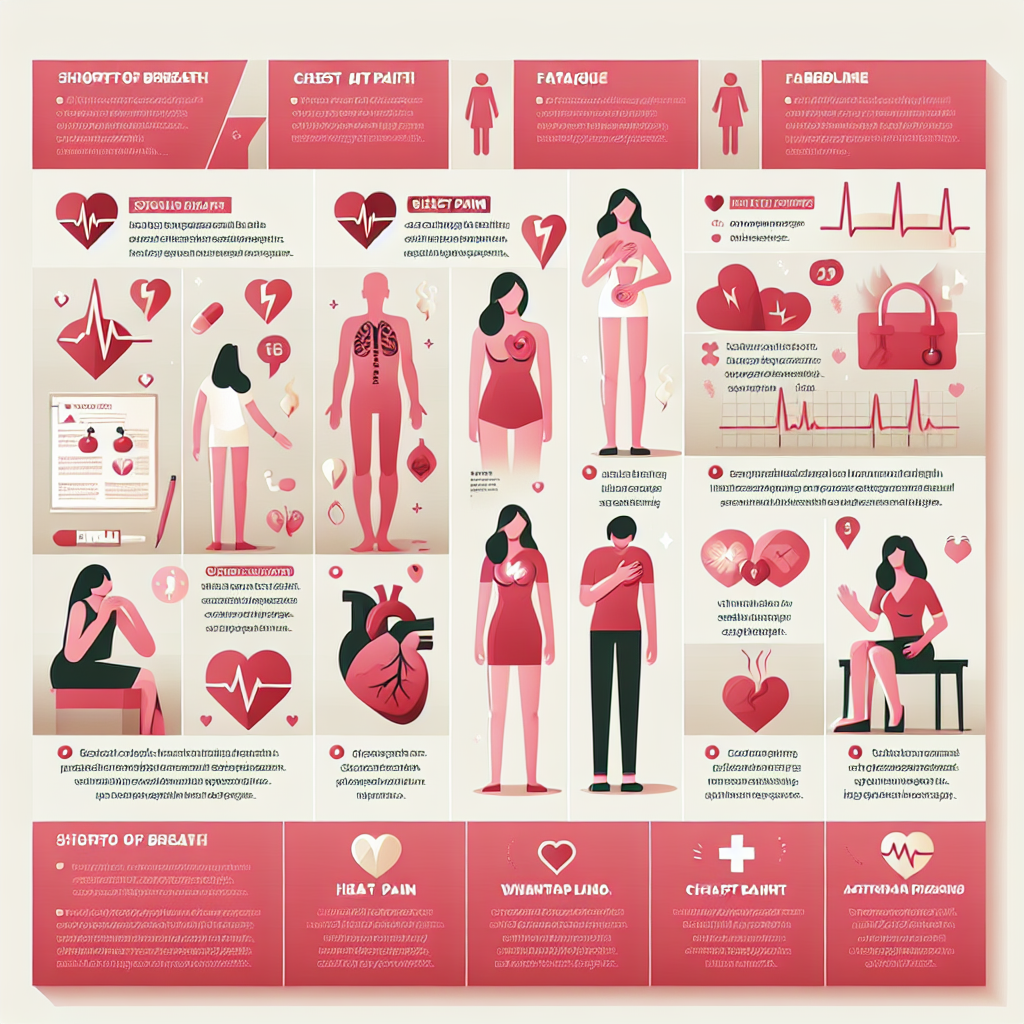
Women may experience different symptoms of heart disease compared to men, which can often be overlooked or misinterpreted. These symptoms may include chest pain or discomfort, shortness of breath, nausea, dizziness, and fatigue. It is important for women to be aware of these symptoms and seek medical attention if they notice any concerning signs.
Heart disease is the leading cause of death in women worldwide, with symptoms often differing from those seen in men. Despite the high prevalence and mortality rates associated with heart disease in women, there is a lack of awareness and understanding of the symptoms specific to female patients.
Recognizing the signs of heart disease in women is crucial for early detection and timely intervention. Women may experience atypical symptoms such as fatigue, nausea, shortness of breath, and back or jaw pain, which can be easily mistaken for other health issues. This highlights the importance of educating women, healthcare providers, and the general public about these lesser-known symptoms to prevent underdiagnosis and improve outcomes.
Research has shown that women are often underrepresented in cardiovascular studies, leading to gaps in knowledge about how heart disease manifests in female patients. Greater emphasis on gender-specific research is essential to develop tailored diagnostic and treatment strategies that consider the unique cardiovascular risk factors in women. By closing this knowledge gap, healthcare professionals can provide more personalized care and improve the overall cardiovascular health of women.
Heart disease in women can present with a variety of symptoms that may differ from those typically seen in men. Studies have shown that women often experience subtle signs of heart issues that are commonly overlooked, leading to underdiagnosis and under-treatment of their condition. Understanding the nuanced symptoms of heart disease in women is crucial for timely intervention and better health outcomes.
One of the key symptoms of heart disease in women is chest discomfort or pain. This pain may not always be the classic crushing sensation often associated with heart attacks. Instead, women may experience more vague discomfort, pressure, or burning in the chest. This difference in symptom presentation can lead to delays in seeking medical attention, as women may not immediately recognize these sensations as potential signs of heart problems.
Additionally, women with heart disease may exhibit symptoms such as shortness of breath, fatigue, nausea, and dizziness. It is important to note that these symptoms can be nonspecific and may overlap with other health conditions. Therefore, proper evaluation by a healthcare provider is essential to accurately diagnose heart disease in women and initiate appropriate treatment.
By recognizing the unique symptoms of heart disease in women, both individuals and healthcare professionals can work together to improve early detection and management of this significant health issue. Educating women on the various presentations of heart disease is crucial for promoting heart health and reducing the burden of cardiovascular disease in the female population.
Identifying the symptoms of heart disease in women is crucial for timely diagnosis and treatment. While chest pain is a commonly known symptom, women may experience subtler signs such as shortness of breath, fatigue, or nausea. These symptoms are often overlooked or attributed to other conditions, leading to delayed intervention.
Understanding the unique presentation of heart disease in women can help healthcare providers offer more targeted care. By raising awareness about atypical symptoms and risk factors, we can empower women to prioritize their heart health and seek appropriate medical attention. Regular screenings and promoting a heart-healthy lifestyle are essential steps towards reducing the incidence of heart disease in women.
One of the key challenges in understanding the symptoms of heart disease in women is the atypical presentation of these symptoms. Unlike the classic symptoms often seen in men, such as chest pain or discomfort, women may experience subtler signs like nausea, jaw pain, or extreme fatigue. This difference in presentation can lead to underdiagnosis or misdiagnosis in women, delaying necessary treatment.
Furthermore, another limitation is the underrepresentation of women in cardiovascular research. Historically, studies have predominantly focused on male participants, leading to a gap in knowledge regarding how heart disease specifically affects women. This lack of gender-specific data can impact the accuracy of diagnostic tools and treatment protocols for female patients.
As awareness about heart disease in women continues to grow, the future outlook for early detection and prevention is promising. With advancements in medical research, more tailored diagnostic tools and treatment options specifically designed for women are being developed. It is crucial for healthcare providers to recognize and address the unique symptoms and risk factors associated with heart disease in women.
Moreover, ongoing advocacy efforts aimed at educating women about their heart health and encouraging proactive lifestyle changes are making a significant impact. By empowering women to prioritize self-care and seek timely medical attention, we can strive towards reducing the prevalence of heart disease-related complications among women. The collaboration between healthcare professionals, researchers, and policymakers is essential in shaping a future where heart disease in women is effectively managed and prevented.
Understanding the symptoms of heart disease in women is crucial for early detection and intervention. By being aware of the differences in how heart disease can manifest in women, individuals can better protect themselves and their loved ones. It is important for women to pay attention to not only the classic symptoms like chest pain, but also the subtler signs such as fatigue, shortness of breath, and nausea.
Early detection is key in managing heart disease effectively. Women should not ignore any unusual symptoms and should seek medical attention promptly if they suspect heart-related issues. Regular screenings, a healthy lifestyle, and managing risk factors like hypertension and diabetes can significantly reduce the chances of developing heart disease.
Understanding the symptoms of heart disease in women is crucial for early detection and proper management. Research shows that heart disease presents differently in women compared to men, often leading to underdiagnosis and delayed treatment.
Key symptoms of heart disease in women include chest pain or discomfort, shortness of breath, nausea, fatigue, and lightheadedness. These warning signs should not be ignored, as timely medical intervention can greatly improve the prognosis.








